
Ever since living in Manhattan in the 1980s, I have fond memories of the vintage postcards depicting the emerging metropolis of the early 20th century. I love the visual of the anticipation of a city growing vertically at an increasingly rapid pace. Skyscrapers were like chess pieces added to the Commissioners’’ Plan of 1811 (plan that set in place Manhattan’s grid between Houston and 155th Street) allowing the skyline to become one of the wonders of the 20th century and the envy of the modern world. Each skyscraper surpassed the other as they were decorated with increasingly elaborate and often pastiche styles, while integrating new technologies and patents of the nascent construction industry.
Golden Age of postcards
Following the Golden Age of Postcards (1907-1915), a new type emerged. With the advent of lithograph printing techniques, images of landmarks and lesser-known places were reproduced on a linen-style support that gave them a nice touch due to their slightly embossed texture. The coarse and uneven surface of the paper was fabricated with a high rag and cotton fiber content. In the early 1950s these postcards were replaced by photographic paper. Of course, all of these early attributes give vintage postcards an even more special and nostalgic feel compared to the slick and two-dimensional high-quality color ones we purchase today at tourist souvenir traps.
I collect vintage postcards, along with miniature metal buildings (over three hundred and fifty to date and still counting) as well as plastic snow globes featuring miniature city scenes. The postcards are proudly showcased on original postcard stands, which are in fact today very difficult to get one’s hands on. I mention this, as early postcards were different in size compared to today’s, thus they require a stand that fits their smaller rectangular size (5.5 x 3.5 in). It took time to secure two stands for my collection, but I now feel that I am like an old drugstore or Five & Dime store clerk selling memorabilia of my beloved city.

Metropolis of tomorrow
What makes vintage postcards so appealing for collectors both now and in the past, is that they have a distinct look beyond their subject matter. For example, showcasing the emerging modernist cityscape of Manhattan, which forms the bulk of my collection. These often translate the vision of the 1927 German expressionist cult film Metropolis or the daring views of Manhattan by Hugh Ferris (Image 1 above).
In their own right, and beyond being as an easy way to stay in touch with friends and loved ones—rather than writing lengthy letter—postcards served as early documentary images of their era and technological advances. Early 20thcentury innovations in photography, printing, and postal distribution, made them popular. Following a rising middle class that had access to non-essential goods through commerce, and advertisements capitalizing on the need to claim class distinction, the dissemination of postcards increased dramatically in number during that period.
Thus, responding to this increased popularity of postcards, views of iconic landmarks were produced and often reprinted several times. This is particularly true when, in 1905, “almost one billion [postcards] were mailed in the United States,” without counting a rising interest in collecting them to serve the vanity of upper-class home gatherings.
Postcard types
When researching my postcard collection, I was fascinated to discover between similar images, flagrant or subtle scenic alterations where details were deleted, exaggerated, or added. Case in point, for the view of the Public Library and Fifth Avenue, New York (Image 2 above) the landscape features matching views of buildings, cars, pedestrians, and the growing urban furniture of a rising modern city. However, between reprintings, select vehicles were rendered either gray or colored green, and the background sky was doctored to suggest an early evening sunset to the north of Manhattan with improved dramatic cloud formations! Artistic liberty seemed fashionable when selling the dream of a port to the New World.
At times, comparing two other similar views down Fifth Avenue, again featuring the iconic flagship of the New York Public Library (designed by Carrère and Hastings), the inclusion of cartoon-like yellow taxis, the precursors of the famous checker cabs of the 1950-80s (Image 3 below) added a childlike joy among the other blue cars. This variation of the foreground might be a result of reframing the view by slightly panning out to include the busy intersection with 42nd Street.

White borders were de rigueur because they were designed to save ink, yet suggest miniature paintings of contemporary life while leaving space to describe the landmark with a sophisticated system of numbering, in this instance above the image.
Skyline through vintage postcards
Following my first blog on vintage postcards from New York, I retrieved several views of the skyline of Manhattan taken from New Jersey. I was enamored by the evidence of the growing city that could be traced through these postcards. I have researched the buildings and need to continue to complete my identification of the remaining ones. If you recognize any in the postcards below, please let me know. Enjoy!
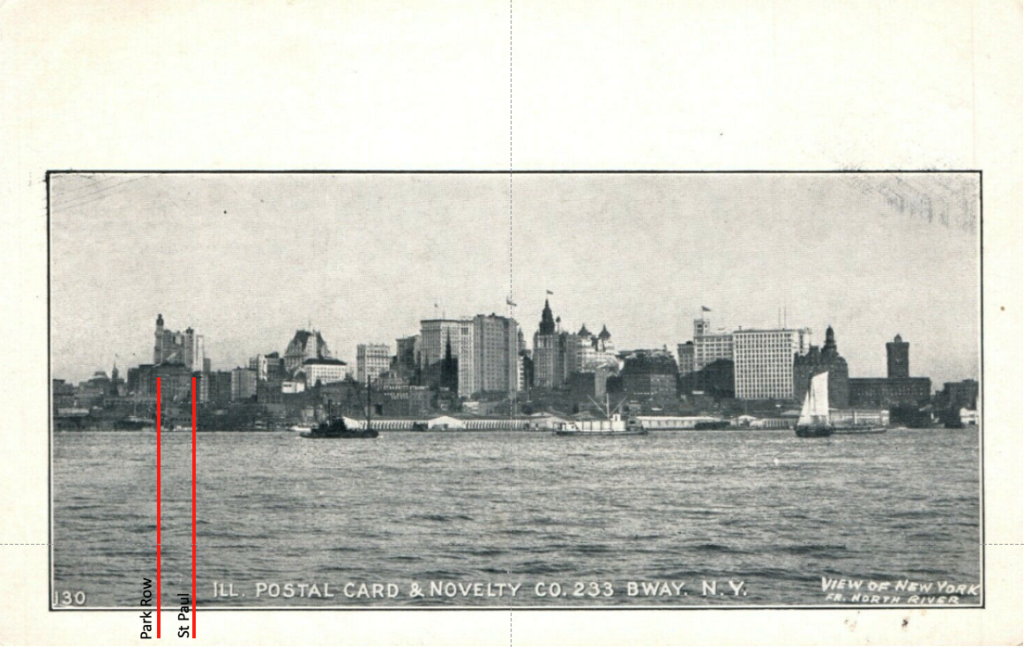
A very early photograph of the Manhattan downtown skyline from New Jersey. To the far left is the Park Row building (1897-1899), located at 21 Park Row at the northern edge of the Financial District in lower Manhattan near City Hall. At that time, it was one of the world’s tallest buildings with 31 stories which included two four-story cupolas. This changed after the completion of the Singer building in 1908 (the card predates this). To its immediate south on Broadway is the St Paul Building (1898) with its iconic coronation set of double-height iconic colonnades.

An equally early photograph showing the steeple of Trinity Church (second iteration after the Great New York City fire in 1776. The one that we know today was erected from 1839 to 1846.

Not easily recognizable at first, the steeple belongs to Trinity Church (1790), located at the intersection of Wall Street and Broadway. To its right is a slender skyscraper, the Empire Building (1887-1898), located at 71 Broadway, on the corner of Rector Street.

Further south of the Park Row building is the Trinity Building (a white building perpendicular to the Hudson River). It was constructed in 1907 as an office building (designed by Francis H. Kimball) and was located at 115 Broadway. It features Gothic inspired attributes that harmonize with neighboring Trinity Church.
To its immediate right, butterflying Trinity Church is the Empire Building (featured in a dark shade). Located at 71 Broadway it reflects a Classical Revival Style, and was completed in 1898.

To the left Park Row are the Hudson Terminal Buildings (in white with dark pyramidal roofs) built between 1908-1909, these two large structures are located at 30 and 50 Church Street at the intersection of Cortland Street. Both buildings house the R.R. Company’s Terminal and office space, with trains traveling via the Downtown Hudson Tubes under the river between Manhattan and New Jersey, tracks that now serve as the PATH. At the inauguration of the building, it was the world’s largest office complex.
To its right, is the slender red 47 story Singer Building with its famous domed top and distinctive lantern towering over the entire financial district skyline. Designed by Ernest Flagg, the Singer Building is located at 149 Broadway at the intersection of Liberty Street (1908, demolished 1968). Designed in a Beaux-Arts style, it was the tallest building in the world between 1908-1909.
Directly in front of the Singer Building (featured in white slightly to the left), and constructed during the construction of the Singer Building, is the City Investing Company Building completed in 1908 (demolished 1968 with the Singer Building to make One Liberty Plaza), located on Cortlandt Street between Church Street and Broadway. Its French Mansard roof contains six stories and an attic.
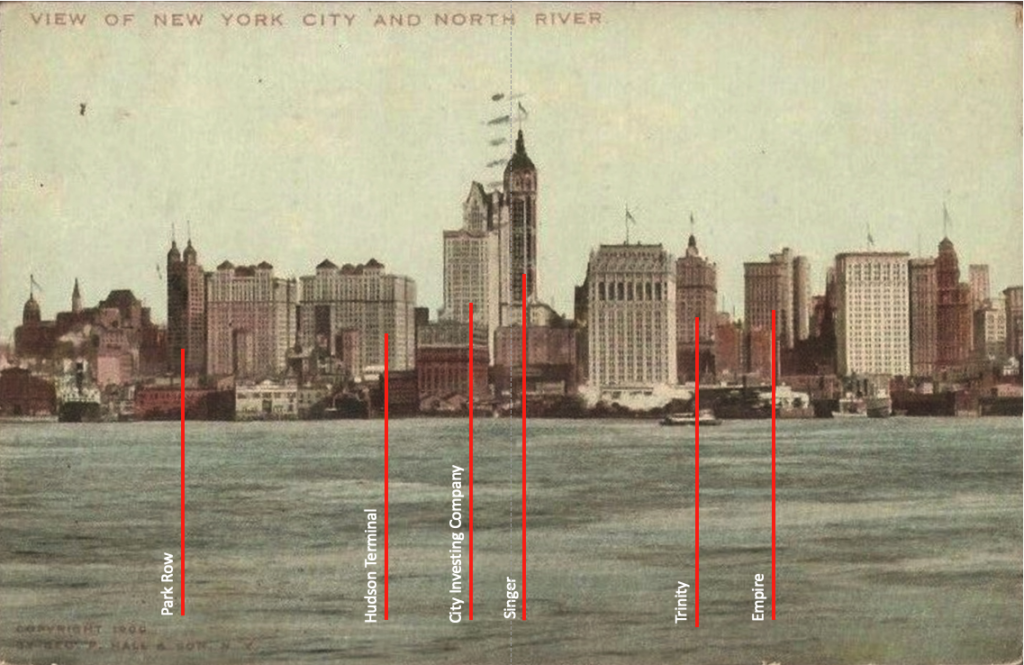
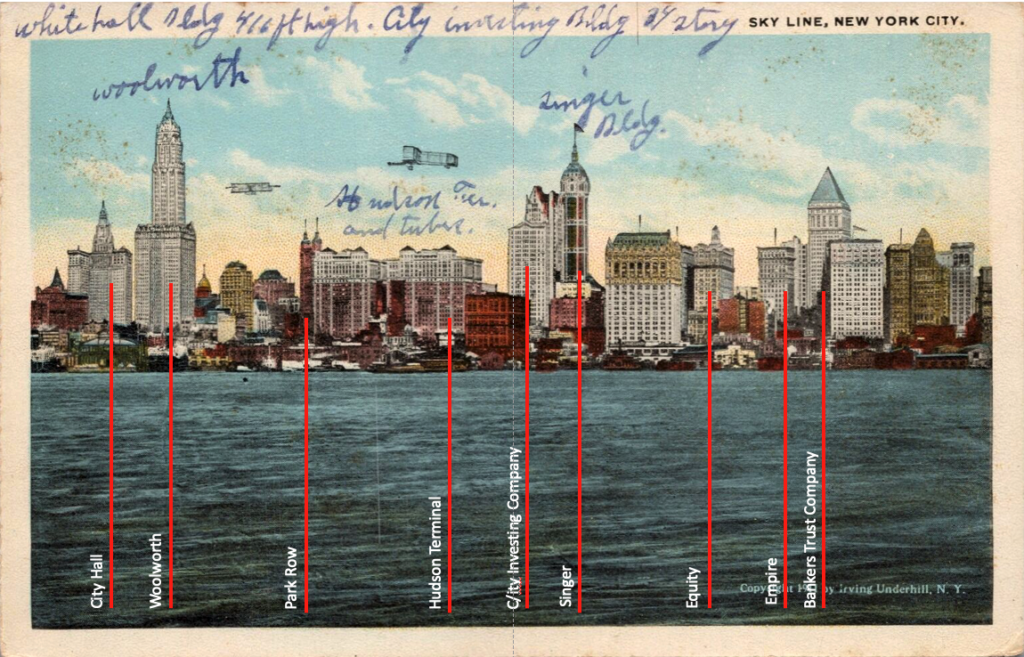
Back of postcard: SKY LINE OF NEW YORK CITY Skyline of Lower Manhattan from Jersey City showing the World’s greatest sky scrapers. Manhattan island, comprising 19.65 square miles was purchased from Indians in 1926 for $24.00 is valued now at 440,200.000. The lower end of Manhattan has an office population of 500.000. Land here is work from 4200 to $600 a square foot.
Two important additions are visible in this postcard. First, to the left, the famous cathedral-like Woolworth Building (1912) that towers over all existing skyscrapers and marks a new era in the skyline of New York City. It is located at 233 Broadway and designed by architect Cass Gilbert. To its left in the immediate distance is the Manhattan Municipal Building (1914), designed by McKim, Mead & White, located at Centre Street. It serves as offices for expanding governmental demands of space.
The tallest building on the right -with the pyramidal top (reminiscent of St Mark’s Campanile in Venice) is the Bankers Trust Company (1912) located at the intersection of Wall and Nassau Streets. Curiously, this postcard as well as the following two are copyrighted 1911, a year when the building was only under construction, possibly wanting to publicize it prior to completion.
Note the inclusion above the skyline of flying machines invented as the first motor-operated flight by the Wright Brothers took place in 1903.

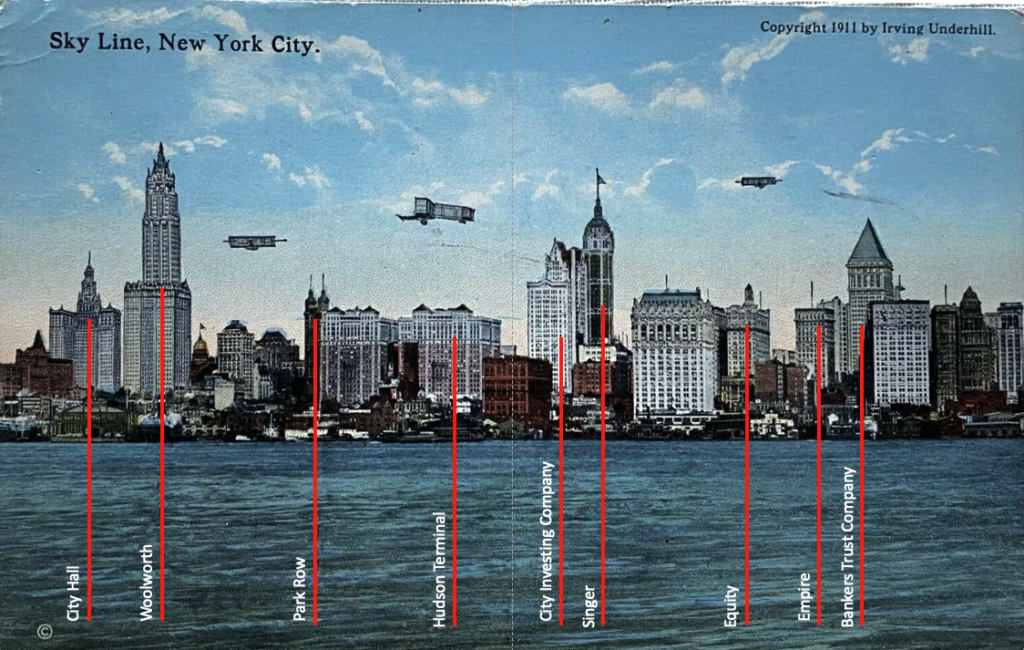
Below the third airplane is the neoclassical style Equitable Building (1912-1915) located at 120 Broadway between Pine and Cedar Streets. The Equitable Building had no required setbacks to the street, and the dramatic shadows cast were a partial reason for the 1916 Zoning Resolution.
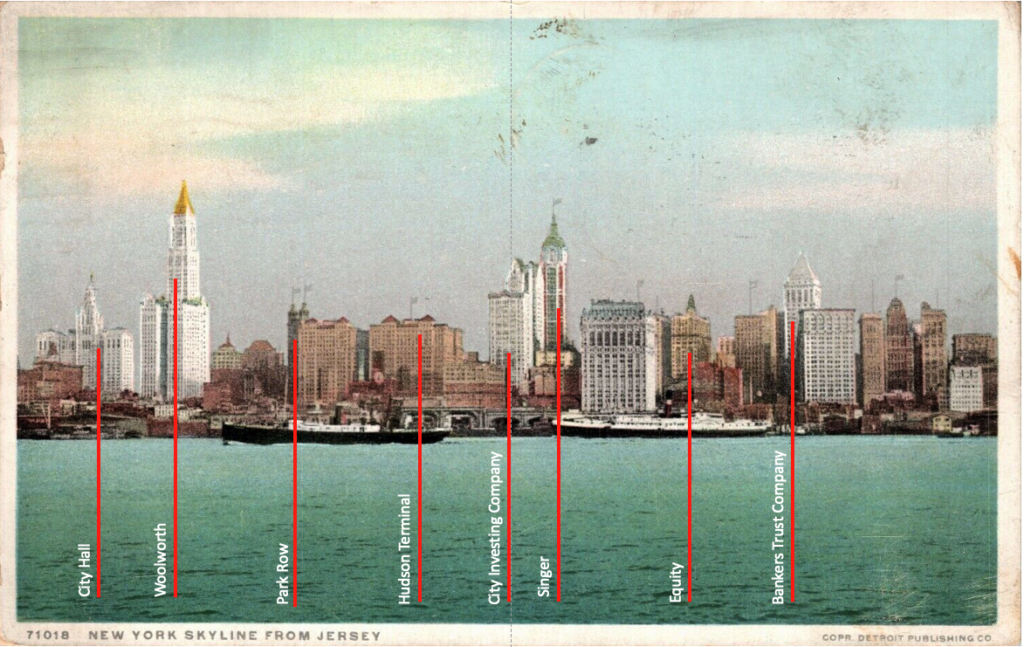

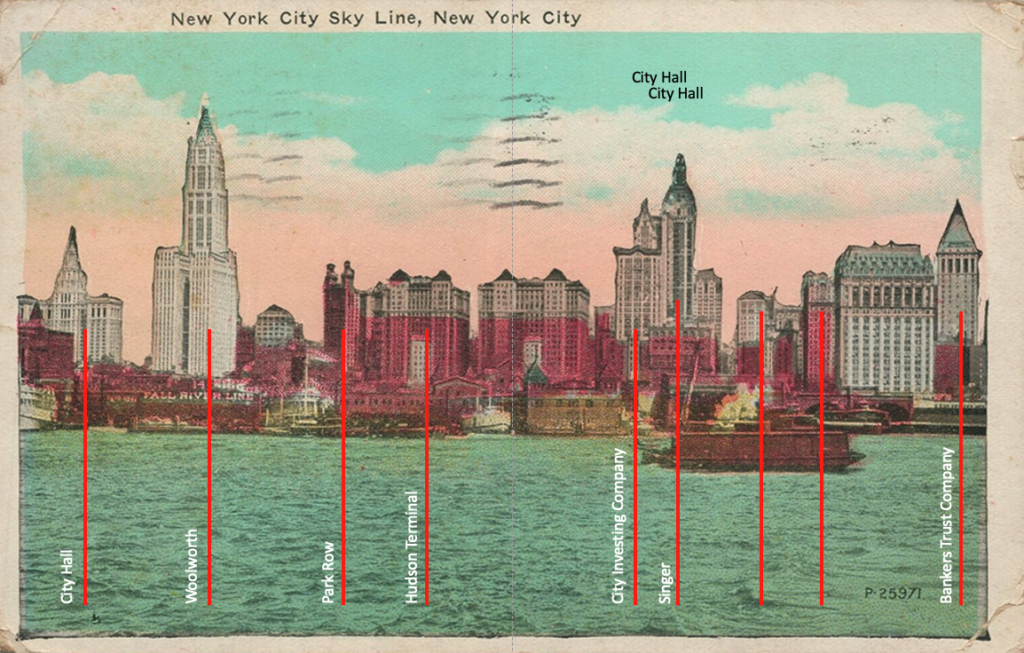
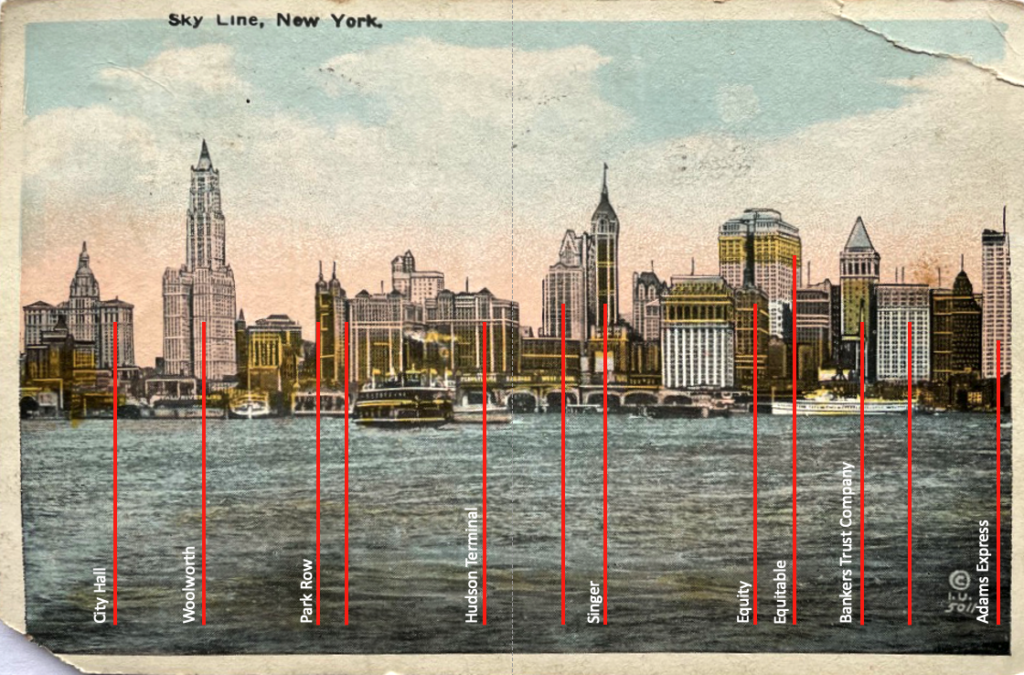
Far right is the 33 story Adams Express Building, home of the New York State Insurance Dept, located at 61 Broadway. Completed in 1914, the style of the structure is called palazzo.
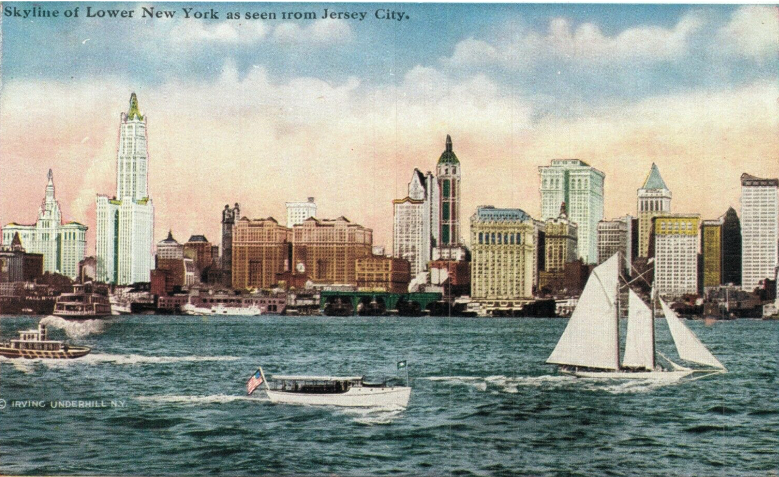
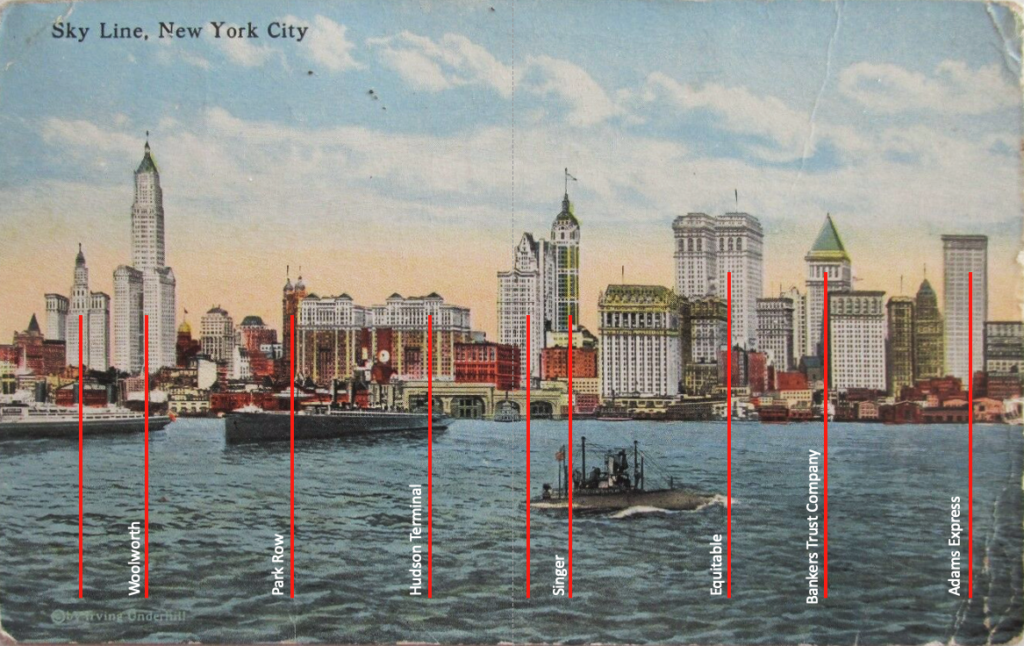
Back of postcard read: NEW YORK SKYLINE Showing skyline of Manhattan from Jersey City. Manhattan Island 19.65 square miles, was purchased in 1626 from Indians from about $24.00, land value now $4,020.000.000. Total realty value with improvements, is $6,075.000.999, and average of $432.000 per acre. The island has 2,331,542 inhabitants, the lower end has an office population of 400,000. Land there is worth from $200 to $600 per square foot and office space rents at from $1 to $40 per square foot.
Note the military ship and submarine in front of the skyline.

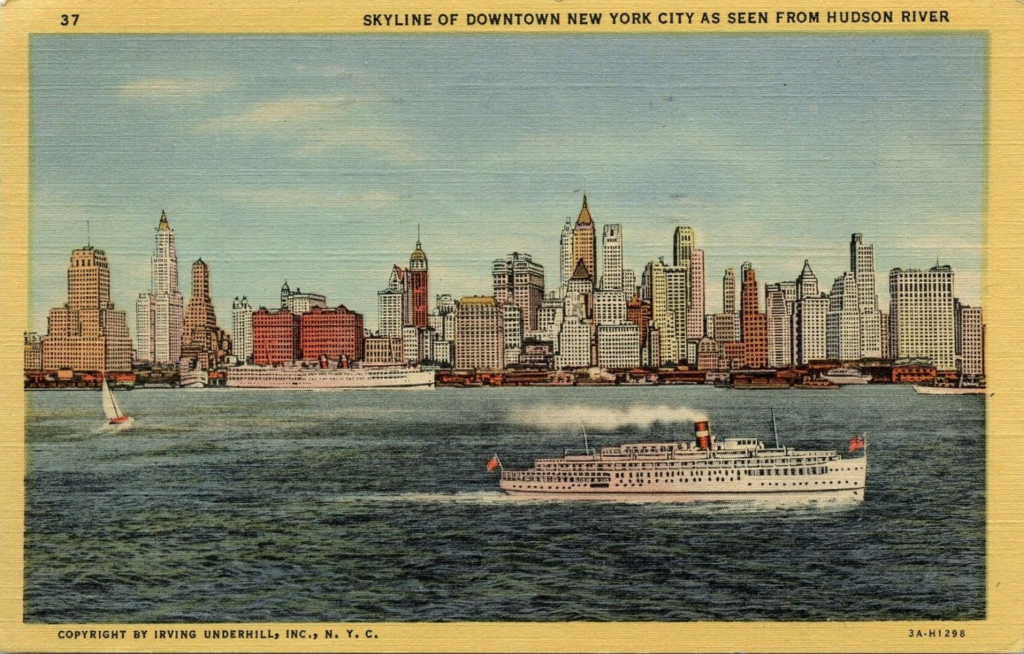

Back of postcard: The Skyline of New York City, the Magic Island of Manhattan, is an awe-inspiring spectacle of great beauty. Its towering sky-scrapers pierce he very heavens, forcible driving home the fact that this America is indeed the “Land of Progress and Promise.”
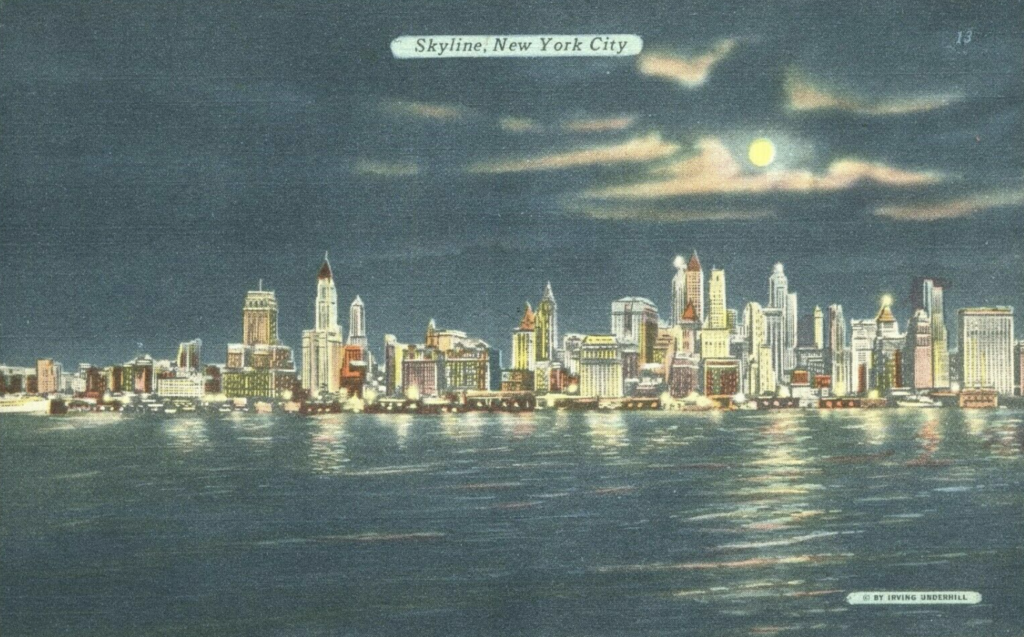
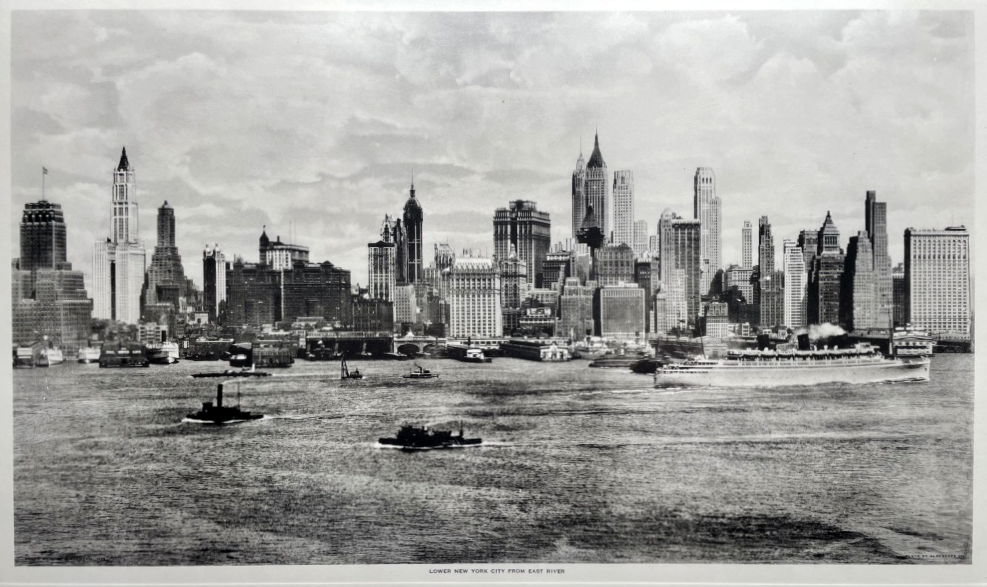
Additional blogs pertaining to New York City
Vintage New York Postcards: Part 1
New York vintage traffic signals